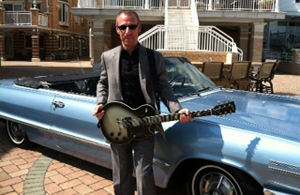The Complete Guitarist: Using Your Influences to Find Your Voice

One of my many fine guitar students really loves Slash. No, I mean he really, really, really loves Slash.
During our lesson the other day, I mentioned other guitarists I felt he should be listening to to give him a more well-rounded listening experience as a young guitarist.
As part of his homework assignment, I wrote down the names of these amazing players and told him to look them up on YouTube — and to not listen to Slash for a week. He looked at me and said, "This is the worst homework ever."
I had to laugh because we've all been there. We've all immersed ourselves in our influences and copied every single lick, stage move and nuance of their playing. While this is an important starting point, there comes a time where we all had to shed these primary influences and seek out others — musical and non-musical — in order to grow as a guitarist, musician and as an individual.
Musicians are, for the most part, creatures of habit, happy to feel safe in one place. It takes courage to have open ears, hearts and minds to expand our creativity into uncharted territories. In this blog, I will discuss using influences to discover our own unique voice on the instrument.
Let's say you have a great chord progression, but you want to spice it up a bit. You can, for example, listen to the outstanding lead/rhythm work that Pete Townshend uses on "Won't Get Fooled Again." You also can break up the chords to be more spacious and less "rock." Listen to how Alex Lifeson of Rush uses chords.
Another great example of using different textures for chord work is Andy Summers from The Police. He often uses extended chords arpeggiated and different voicings to achieve a very dramatic effect. Case in point being "Every Breath You Take" and "Message In A Bottle." And speaking of Andy Summers, check out the introduction to "Bring On The Night." He uses a picking pattern taken straight from "Etude No. 1" by Heitor Villa-Lobos, the great classical guitarist/composer.
All the latest guitar news, interviews, lessons, reviews, deals and more, direct to your inbox!
That is an excellent example of thinking outside the box to make something your own. Another excellent example of thinking outside the box is Eric Johnson's use of right-hand "chime harmonics," which he borrowed from the late jazz guitarist Lenny Breau. If you want to use some effects to create a different sound or texture for a chord progression, listen to how The Edge uses delay on "Where The Streets Have No Name." Want to try some unique alternate tunings? Listen to the late Michael Hedges and his strange and beautiful tuning variations and compositions played on acoustic guitar and harp guitar.
Want to spice up your lead playing? Try some two-hand tapping techniques. The inherent problem with two-hand tapping is that you will always be compared to the master, Eddie Van Halen. Listen to the amazing guitar work of Steve Vai and the late Randy Rhoads. Both are masters of two-hand tapping, but they all have their own unique twist.
If you want to expand even further than that, check out the right-hand tapping work of Brian May during the solo part of "It's Late." It's brilliant and unique -- like all the players I just mentioned above.
Are you in a band with another guitarist and want to spice up a guitar passage in one of your songs? Listen to the unique and melodic twin-guitar harmonies of Scott Gorham and Brian Robertson from Thin Lizzy on the Live and Dangerous recording.
Tired of playing too fast? Listen to the beginning lead of "Machine Gun" by Jimi Hendrix. He holds that first note forever and manages to capture the essence of war during that whole lead section. Tired of playing too slow? Listen to the work of Yngwie Malmsteen. My point being that it's OK to shred once in a while, and its OK to play one note once in a while too, as long as both styles are played with feeling, integrity and meaning.
You also can use non-guitar influences to take your guitar playing to the next level. Listen to the phrasing of the late jazz saxophonist John Coltrane on "A Love Supreme" and "Naima." Check out the beautiful timbre and tone of Miles Davis on the Birth Of The Cool and Kind Of Blue recordings. Listen to the drumming of the late Buddy Rich to add more challenging rhythm work to your repertoire.
Be brave. Challenge yourself. There are influences and different sounds we can find everywhere. From Brahms to Black Sabbath, from Slayer to Segovia, its all there for us. All we have to do is open our minds and listen.
Now get off this Internet thing and pick up your guitar and play. And I mean it!
Guitarist Richard Rossicone is a veteran of the New York City and Long Island original and cover band scene. He's been playing since he was 8, when he attended his first concert (Kiss) and saw Pete Townshend smash a guitar. He has studied with various instructors over the years, which led him to a career in music therapy. He began his educational journey at Queensboro Community College, where the faculty introducing him to classical music. He received his associate's degree in fine arts in 1997 and went on to receive his bachelor's in music therapy in 2001 and his master's in music therapy from New York University in 2004. He's been Board Certified as a music therapist since 2002. Richard continued his studies at C.W. Post University, pursuing a second master's degree in classical guitar performance and music history, studying under Harris Becker. He's been teaching guitar, piano and theory since 2002 and in 2006 started his own company, Rossicone Music Studios. Richard is the co-lead guitarist in Bad Habits, NYC's premier Thin Lizzy tribute band. Visit him at Axgrinder.com
